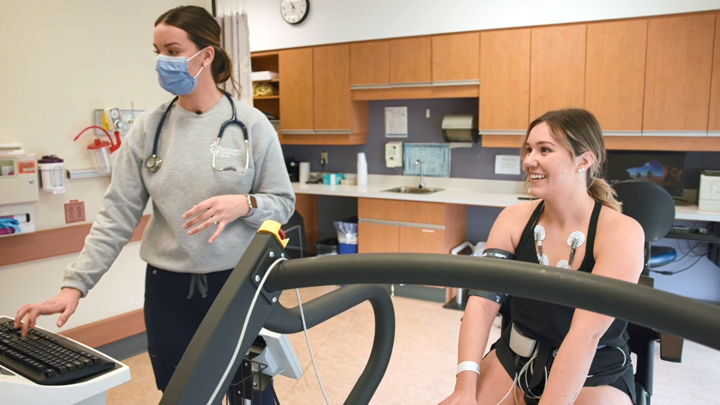
February 28, 2024

A member of her care team oversees cardiac stress testing on Saige Godberson as part of her treatment plan at the Mazankowski Alberta Heart Institute. Photo by Evan Isbister.
Story by Marni Kuhlmann | Photo by Evan Isbister
EDMONTON — Only 28 with an active, busy life, Saige Godberson never imagined she’d be learning to live with heart disease. She’s a nurse, a runner, a snowboarder, a barre and Pilates instructor — with none of the traditional risk factors for cardiovascular disease.
That all changed in early 2023.
“I was out running and noticed I was having this severe chest pain feeling, and started having these abnormal symptoms,” says Godberson. “I brought myself into emergency, with the classic chest tightening, palpitations, and severe chest pain. They did the preliminary basic cardiac testing, ECG, chest X-rays, blood work — and they all looked normal. Nothing showed up as being acutely wrong with my heart.”
Unfortunately, Godberson’s experience isn’t rare.
“We’re finding an increasing number of patients where the coronary angiogram is clean, showing no blockages — and what we’ve learned over time is that there can be mini blood vessels in the heart that we can’t see on the angiogram,” says Dr. Kevin Bainey, Director of the Adult Catheterization and Interventional Cardiology Program at the University of Alberta Hospital’s Mazankowski Alberta Heart Institute (Maz).
“We’re now able to use new physiology testing during a coronary angiogram, which helps us to diagnose microvascular dysfunction. During the same procedure, we can also test for coronary artery spasm which can be another cause of chest pain.”
Godberson is one of the first patients to undergo this new innovative testing at the Maz. If no blockage is found during the coronary angiogram, doctors insert a tiny pressure sensitive wire through the angiogram tube into the heart’s arteries. It can quickly assess microvascular issues and can check for coronary vasospasms.
The Maz team is one of the first Cardiac Catheterization Labs in Canada to offer this advanced technology. Dr. Bainey calls it a gamechanger for hundreds of women, living with unexplained chest pain.
”We found that many female patients with chest pain are often told it is not cardiac. They’re often put on anti-anxiety or anti-depressant medications, and we are now learning that their physiology can explain their symptoms. To be able to provide answers to patients is a tremendous relief,” adds Bainey.
Godberson agrees that struggling with no diagnosis is the hardest part.
“The cardiac symptoms and chest pain were awful and had severely impacted my life, but more than any of the physical stuff, it was the mental impact. It was so hard to doubt myself. I trusted my gut that something was wrong. I knew something didn’t feel right, and I knew there had been this sudden change in my health.
“But when you’re being told you’re fine, there’s nothing wrong with your heart and everything is normal, you doubt yourself. The mental impact is really challenging,” she adds.
“I actually started crying during the procedure when they gave me this diagnosis. Happy tears. I was just so grateful to have an answer. It was the biggest weight off my shoulders.”
Godberson continues to work on a treatment plan with her care team, and hopes to return soon to her regular active life.
To learn more about the physiology testing equipment for microvascular dysfunction and coronary vasospasm, speak to your doctor about a referral to a cardiologist at the University of Alberta Hospital’s Mazankowski Alberta Heart Institute.